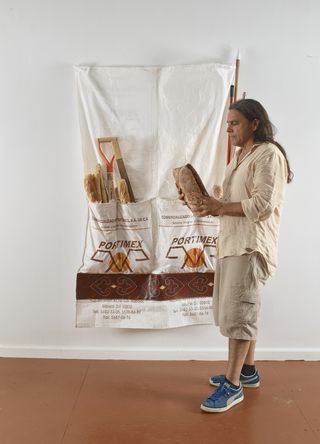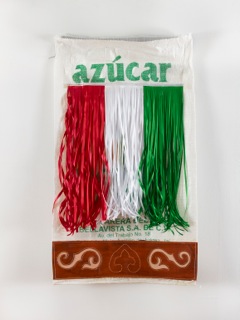
Michael Pribich is an artist’s artist who attended 360 Xochi Quetzal in the Spring of 2015. His work is smart, embedded with layers of meaning, beautiful, both pleasing and challenging, often monumental and deeply informed by sense of place. Michael lives and works in New York City and as you will read, also travels the world collecting history, materials and inspiration that he transforms with his keen eye and mind.
In your artist statement you write: “The disparity between classes informs your use of materials….”
Mining the Pueblo is a series of art works that began at 360 Xochi Quetzal. I am still expanding and developing this body of work which utilizes 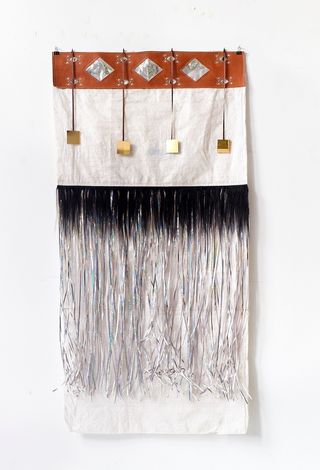 synthetic recycled bags as an art material. These bags are mainly used in construction work to move dirt, bricks and refuse materials. The idea is: take a cheap common material and inject it with new meaning that emphasizes the fluidity and movement of this ‘low material‘ to a place of higher consideration. This is the opposite of using say gesso, canvas and oil paint – more traditional (European) materials – in favor of those specifically linked to the concept. Mining the Pueblo places Mexico’s tradition of work and craft front and center as the concept itself. The leather panels on the bags were done by Victor Parra, a leather worker in Guadalajara, who comes from a family of saddle makers. They are the last generation of working Charros, which adds another layer of meaning and cultural reference. Victor’s contribution is to generate decorative patterns, which refer to vernacular imagery, in the leather stitching. I want the North American audience to look at these patterns as a reflection of its past history with Mexico, Central and South America, and the Caribbean. This history is not commonly taught or acknowledged in the USA, yet this country was built on the backs of slaves, on land taken from Native Americans, and land that was formerly Mexico in the present day western United States.
synthetic recycled bags as an art material. These bags are mainly used in construction work to move dirt, bricks and refuse materials. The idea is: take a cheap common material and inject it with new meaning that emphasizes the fluidity and movement of this ‘low material‘ to a place of higher consideration. This is the opposite of using say gesso, canvas and oil paint – more traditional (European) materials – in favor of those specifically linked to the concept. Mining the Pueblo places Mexico’s tradition of work and craft front and center as the concept itself. The leather panels on the bags were done by Victor Parra, a leather worker in Guadalajara, who comes from a family of saddle makers. They are the last generation of working Charros, which adds another layer of meaning and cultural reference. Victor’s contribution is to generate decorative patterns, which refer to vernacular imagery, in the leather stitching. I want the North American audience to look at these patterns as a reflection of its past history with Mexico, Central and South America, and the Caribbean. This history is not commonly taught or acknowledged in the USA, yet this country was built on the backs of slaves, on land taken from Native Americans, and land that was formerly Mexico in the present day western United States.
Some artists come to a residency with a particular creative game plan. Others just arrive open to whatever inspires them at the moment. How did you approach your residency and how did your studio time compare to what you anticipated?
 What I had anticipated and what resulted from my 360 Xochi Quetzal residency time could not have been further apart. I did not have a preconceived work plan, and did not have a high expectation for producing art works. I thought I would relax and read, and maybe have some Jalisco road trips to learn more about the local cowboy culture. What happened is that I was given an incredible opportunity – a great gift. The Lopez Cotilla residency house was so big and generous that I felt inspired to create new work. The people in Chapala work a lot, and that was an inspiration too. Seeing this dynamic fit into an idea that I had been thinking about for awhile. This concept, called The Infinite Labor of the Cosmic Race, is a body of work that is about immigrant Mexican workers in New York. The idea comes from the Mexican theorist Vasconcelos that claimed a kind of racial purity for Mexicans and posited them as a unique race. His theories are problematic, yet there are aspects of his thinking that attempts to lift the Mexican psyche.
What I had anticipated and what resulted from my 360 Xochi Quetzal residency time could not have been further apart. I did not have a preconceived work plan, and did not have a high expectation for producing art works. I thought I would relax and read, and maybe have some Jalisco road trips to learn more about the local cowboy culture. What happened is that I was given an incredible opportunity – a great gift. The Lopez Cotilla residency house was so big and generous that I felt inspired to create new work. The people in Chapala work a lot, and that was an inspiration too. Seeing this dynamic fit into an idea that I had been thinking about for awhile. This concept, called The Infinite Labor of the Cosmic Race, is a body of work that is about immigrant Mexican workers in New York. The idea comes from the Mexican theorist Vasconcelos that claimed a kind of racial purity for Mexicans and posited them as a unique race. His theories are problematic, yet there are aspects of his thinking that attempts to lift the Mexican psyche.
You travel a great deal. Tell us about where you have been and how this has influenced your work.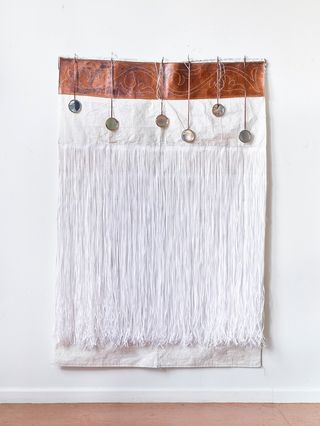
I have been back to Guadalajara twice since my residency. I really connect there, and I want to continue to develop my Jalisco relationships.
I traveled to Tajikistan and Uzbekistan last fall. I have been traveling in Central Asia the last 4 years — a lifelong dream to see the Silk Road cities and other historic sites. This was my third trip, and the first time that I made art works that are specifically influenced by the place. I made a 5-minute video in the Pamir region of Tajikistan that features a farm worker processing wheat with a pitch fork. The video is slow motion and is accompanied by an Abby Lincoln and Max Roach soundtrack. The piece is about the repetition of work required for sustainable living. The Pamir people live amongst the extremely high mountains of Badakshan on the Pyaj River. Their way of life appears to have not changed much in over 2000 years (though they do carry cell phones -). Afghanistan is 100 yards away on the opposite bank of the river
I am currently participating in the Flux Art Fair in New York --‐ an outdoor sculpture fair in Harlem.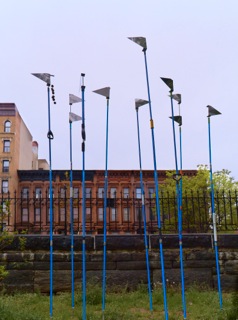 My work Blue Elegy is informed by Zoroastrian and pre-Islamic, pre-Buddhist cultural and religious sites in Central Asia. These settings are often very plain with minimal markings, yet with enormous feeling and presence. Blue Elegy is a series of 12’ high poles made from broom handles on top of which are stainless steel mirror flags. Small bells are attached. Blue Elegy is about the gentrification of Harlem which is not only economic, but also racial and historic; it is the black and brown people of Harlem that are being pushed out. Blue Elegy is a kind of remembrance of the great people and their accomplishments of past and present day Harlem.
My work Blue Elegy is informed by Zoroastrian and pre-Islamic, pre-Buddhist cultural and religious sites in Central Asia. These settings are often very plain with minimal markings, yet with enormous feeling and presence. Blue Elegy is a series of 12’ high poles made from broom handles on top of which are stainless steel mirror flags. Small bells are attached. Blue Elegy is about the gentrification of Harlem which is not only economic, but also racial and historic; it is the black and brown people of Harlem that are being pushed out. Blue Elegy is a kind of remembrance of the great people and their accomplishments of past and present day Harlem.
Tell us about recent and upcoming exhibitions or residencies.
This past year I’ve had works shown at the Museum of Contemporary Art in Detroit, and the Bronx River Art Center in the Bronx. Larger bag versions which incorporate repeating inset mirrors have been proposed to the NYC Parks Department, and to the Festival of Regions in Austria.I am currently working on promoting the works I have already done: I want to find a venue for the large mirror bags, for the Pamir video, and a new setting for Blue Elegy. I will be participating in the Jentel Artist Residency in Sheridan, Wyoming in June15 to July 15, 2016.
Where can we read about and see more of your work?
http://www.michaelpribich.com/
http://www.michaelpribich.com/1iles/artvoices_michael_pribich.pdf In this interview with Emily Colucci, I talk about 360 Xochi Quetzal.
